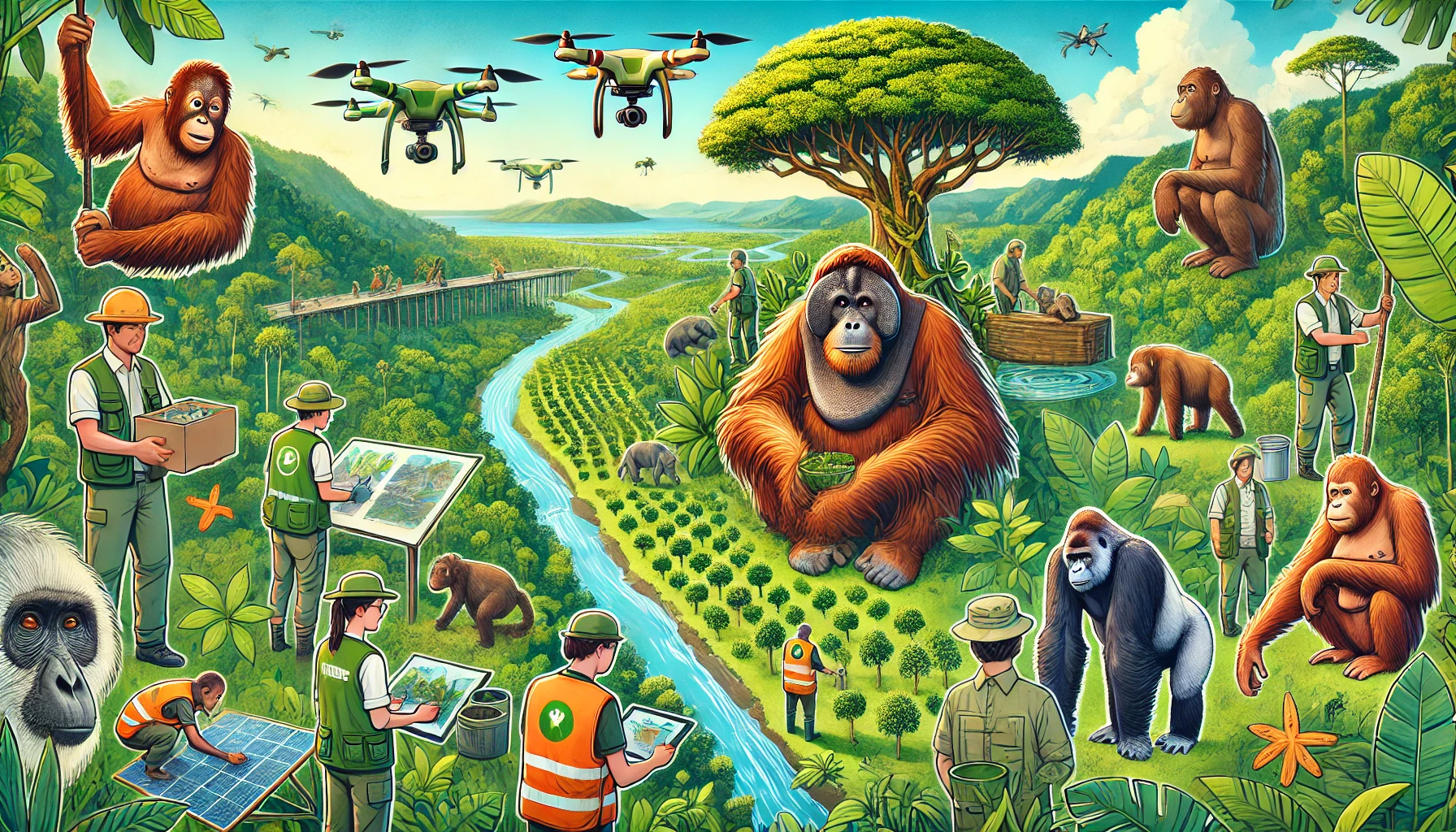Protecting Endangered Primates
As a professional rescuer at Real World Rescue, I’m passionate about shedding light on the urgent need to protect endangered primates. These incredible creatures, our closest living relatives, face numerous threats that jeopardize their survival. In this article, we’ll explore the challenges they encounter and discuss effective solutions to ensure their preservation.
The Importance of Primates in Ecosystems
Primates play a crucial role in maintaining the health and balance of ecosystems. They are key seed dispersers, aiding in forest regeneration and contributing to biodiversity. Without them, the intricate web of life in tropical and subtropical forests would be severely disrupted, leading to far-reaching environmental consequences.
The Major Threats to Endangered Primates
Despite their importance, many primate species are on the brink of extinction. Here are the primary threats they face:
- Habitat Destruction: Deforestation for agriculture, logging, and infrastructure development is the most significant threat to primates. Loss of habitat reduces their living space, food sources, and breeding grounds.
- Hunting and Poaching: Primates are hunted for their meat, which is considered a delicacy in some cultures. Additionally, illegal poaching for the pet trade and traditional medicine further decimates their populations.
- Climate Change: Changes in temperature and weather patterns affect the availability of food and suitable habitats for primates, forcing them to adapt to rapidly changing environments.
- Human-Wildlife Conflict: As human populations expand, primates increasingly come into conflict with humans, leading to injuries and fatalities on both sides.
- Disease: Infectious diseases, often transmitted from humans to primates, can have devastating effects on their populations.
Effective Conservation Strategies
To address these threats and protect endangered primates, a multifaceted approach is required. Here are some effective strategies:
Habitat Protection and Restoration
One of the most critical steps in primate conservation is protecting and restoring their natural habitats. Creating protected areas such as national parks and wildlife reserves helps safeguard crucial habitats from deforestation and human encroachment. Additionally, reforestation projects can restore degraded lands, providing new living spaces for primates.
Anti-Poaching Measures
Combating poaching requires a combination of strict law enforcement and community engagement. Strengthening anti-poaching laws and ensuring they are enforced can deter illegal hunting. Equally important is educating local communities about the importance of primates and involving them in conservation efforts. Community-based initiatives, where locals are trained as wildlife rangers, have proven effective in many regions.
Sustainable Development Practices
Balancing human development with wildlife conservation is essential. Promoting sustainable agricultural practices and eco-friendly infrastructure projects can reduce the impact on primate habitats. Additionally, providing alternative livelihoods for communities dependent on hunting can decrease reliance on primate populations for income.
Climate Change Mitigation
Addressing climate change on a global scale is vital for the long-term survival of primates. Efforts to reduce greenhouse gas emissions, promote renewable energy, and protect forests are crucial. On a local level, conservationists can work to create climate-resilient habitats by preserving a variety of microhabitats that primates can use as refuges during extreme weather events.
Health Monitoring and Disease Prevention
Regular health monitoring of primate populations can help detect and manage disease outbreaks early. Implementing biosecurity measures to prevent disease transmission from humans to primates, such as regulating ecotourism activities and establishing health protocols for researchers, is also essential.
Case Studies: Successful Primate Conservation Programs
Let’s look at some inspiring examples of successful primate conservation programs:
The Jane Goodall Institute’s Work with Chimpanzees
The Jane Goodall Institute has been at the forefront of chimpanzee conservation for decades. Their community-centered conservation approach involves local communities in protecting chimpanzee habitats, promoting sustainable livelihoods, and raising awareness about the importance of conservation. This holistic approach has led to significant improvements in chimpanzee populations in several regions.
The Mountain Gorilla Conservation Efforts
Mountain gorillas, once on the verge of extinction, have seen a remarkable recovery thanks to concerted conservation efforts. Partnerships between governments, NGOs, and local communities have led to the establishment of protected areas, anti-poaching patrols, and ecotourism initiatives. These efforts have not only increased gorilla numbers but also provided economic benefits to local communities.
The Golden Lion Tamarin Project in Brazil
The Golden Lion Tamarin Conservation Program in Brazil focuses on habitat restoration and population monitoring. By replanting forests and creating wildlife corridors, the program has successfully increased the population of these critically endangered primates. Public education campaigns have also raised awareness and garnered support for conservation efforts.
Challenges and Future Directions
While these success stories are encouraging, many challenges remain. Conservationists must continuously adapt to new threats and changing environmental conditions. Collaboration between governments, NGOs, scientists, and local communities is essential for developing innovative solutions and ensuring the long-term survival of primates.
The Role of Technology in Primate Conservation
Technology plays an increasingly important role in conservation efforts. Here are some ways it’s making a difference:
- Remote Sensing and GIS: Satellite imagery and geographic information systems (GIS) are used to monitor habitat changes and track deforestation rates, providing crucial data for conservation planning.
- Camera Traps and Drones: Camera traps and drones enable researchers to monitor primate populations and their behaviors without disturbing them. This technology helps gather data on population sizes, movements, and threats.
- Genetic Analysis: Genetic studies can identify population structure, gene flow, and genetic diversity, aiding in the development of targeted conservation strategies.
- Mobile Apps: Mobile applications allow citizens to report sightings and incidents of poaching, enabling real-time data collection and enhancing community involvement in conservation efforts.
Protecting Endangered Primates
Protecting endangered primates is a global priority, demanding urgent and coordinated efforts. From habitat protection and anti-poaching measures to climate change mitigation and health monitoring, a comprehensive approach is essential. By supporting community-based conservation programs and utilizing advanced technologies like remote sensing and genetic analysis, we can make significant strides in safeguarding these incredible creatures. Together, we can ensure a future where primates thrive in their natural habitats.
How You Can Help
You might be wondering how you can contribute to primate conservation. Here are a few ways to make a difference:
- Support Conservation Organizations: Donate to reputable organizations working on primate conservation. Your contributions can fund critical projects and research.
- Raise Awareness: Use your voice to raise awareness about the plight of endangered primates. Share information on social media, write to your local representatives and participate in advocacy campaigns.
- Adopt Sustainable Practices: Reduce your environmental impact by adopting sustainable practices in your daily life. Support eco-friendly products, reduce waste, and advocate for policies that protect natural habitats.
- Volunteer: Offer your time and skills to conservation projects. Whether it’s participating in a local reforestation effort or assisting with wildlife monitoring, your involvement can have a tangible impact.
Conclusion
Protecting endangered primates is a complex yet achievable goal. By understanding the challenges they face and implementing practical solutions, we can ensure these magnificent creatures continue to play their vital role in our ecosystems. Every effort counts, and together, we can make a difference. Let’s commit to safeguarding the future of primates and the rich biodiversity they support.
Thank you for joining me in this critical discussion. Stay tuned to Real World Rescue for more insights and updates on our conservation efforts.

